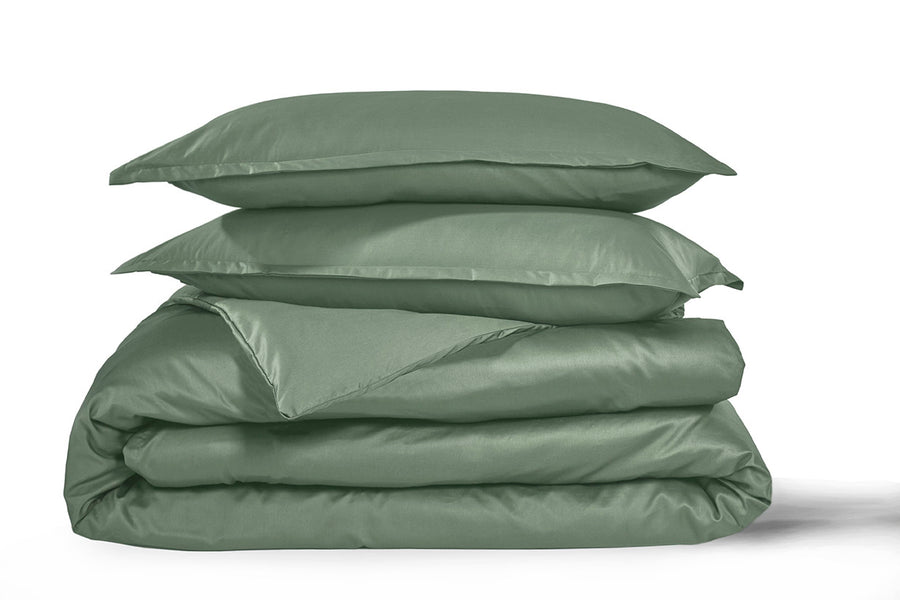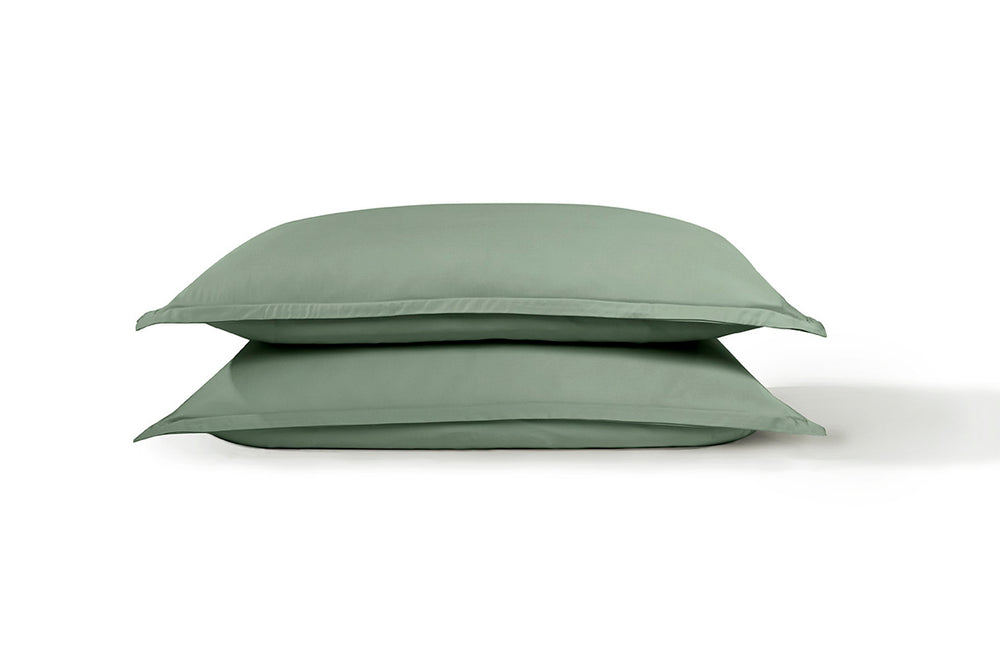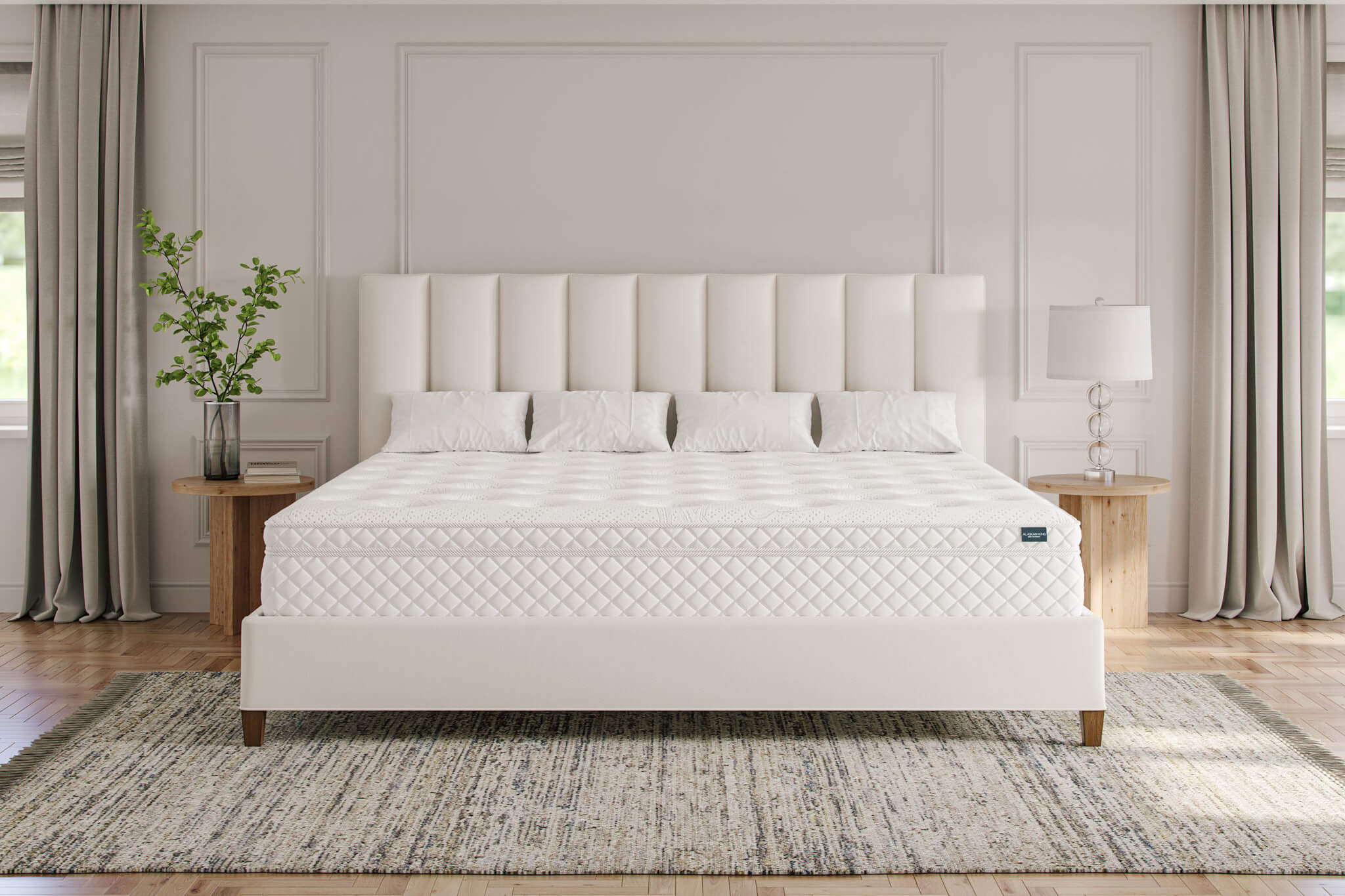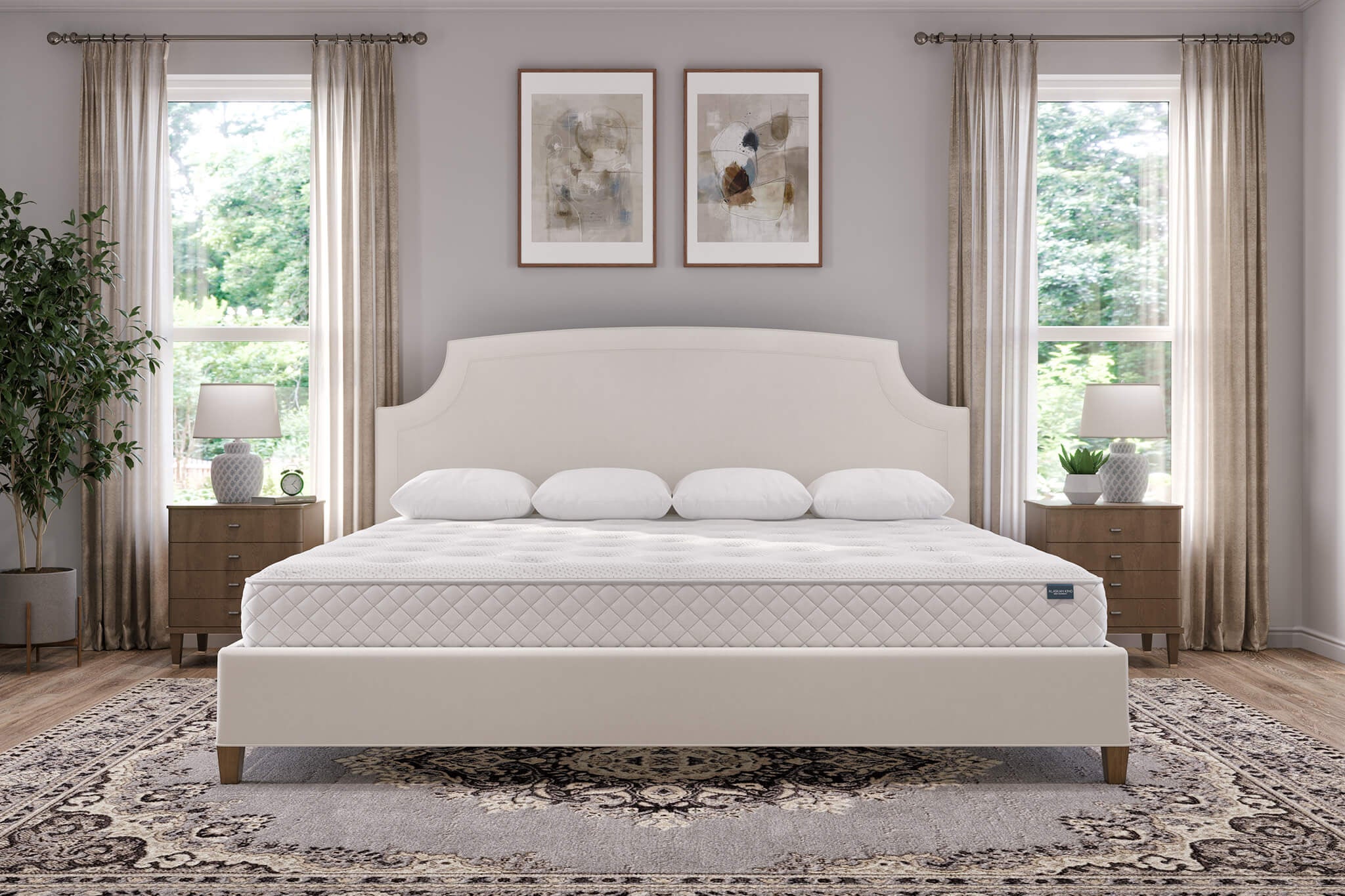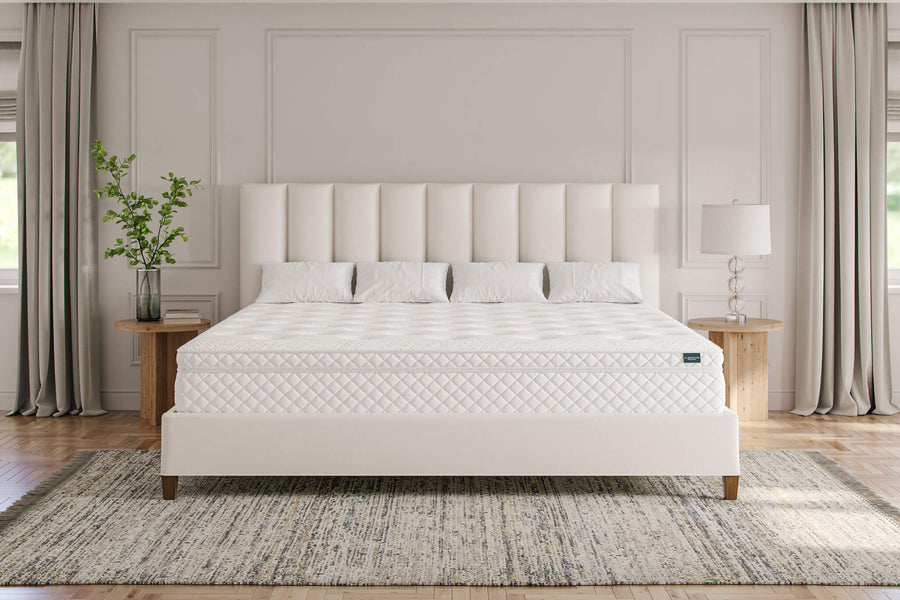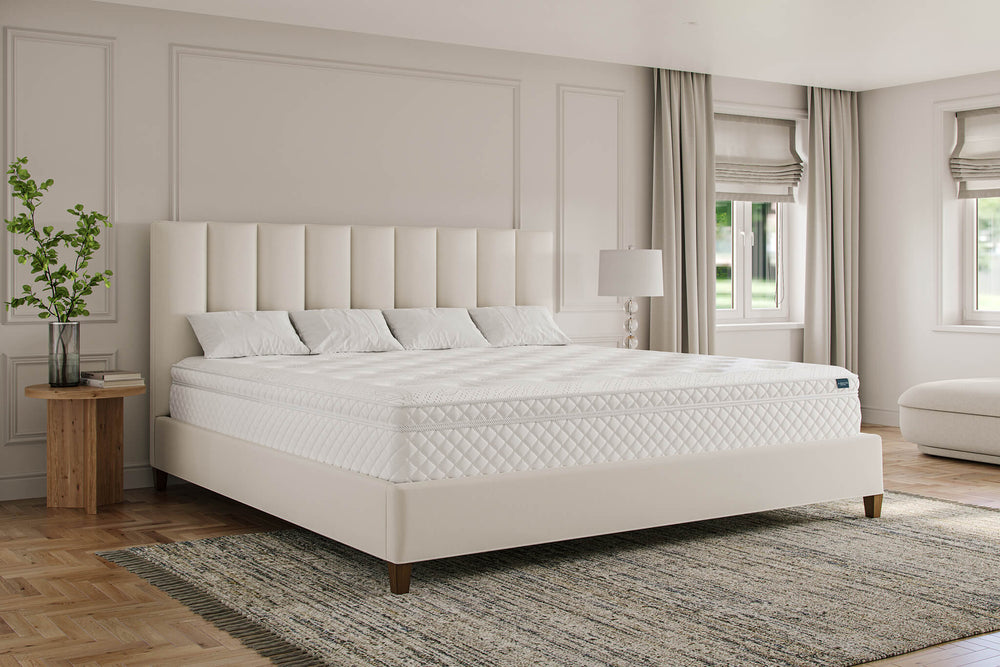7 Proven Techniques to Help You Fall Asleep on Your Alaskan King Bed
You’re lying in bed, ready to let go of the day, but somehow, your mind has other plans. You know that feeling when you’re physically tired, but mentally, you’re running a marathon?
Instead of falling asleep, every little thought, worry, and to-do for tomorrow starts to pile up (thanks, brain). And the more you try to shut it all down, the more awake you feel. Sleep shouldn’t be this hard, right?
It really doesn’t have to be. In fact, there are proven techniques that can help you fall asleep faster, even when your mind won’t stop racing.
In this article, we explore the seven powerful methods you can try in addition to relaxing nighttime activities for a quicker journey into dreamland.
1. Military Sleep Technique (2-Minute Method)
The military sleep technique, popularized by the US Army, is a method that helps soldiers fall asleep quickly, even in stressful environments. The goal is to relax your entire body in just two minutes by focusing on releasing physical tension and quieting your mind.
You do it by systematically relaxing each part of your body and visualizing peaceful scenes to distract yourself from intrusive thoughts that might otherwise keep you awake.
Here’s how:
- Lie on your back with your arms by your sides.
- Start by relaxing the muscles in your face, including your forehead, eyes, cheeks, and jaw. Let your tongue rest naturally in your mouth.
- Allow your shoulders to sink into the mattress to release any tension in your neck and upper back.
- Starting with your dominant arm, let it go completely limp, then repeat with the other arm. Feel the weight of each arm sinking into the bed.
- Focus on slow, deep breaths as you relax your chest and stomach to let go of any remaining tension.
- Relax your legs by starting with your thighs and then moving to your calves and ankles.
- Visualize a peaceful scene, like lying in a canoe on a calm lake, or repeat a simple phrase like “don’t think” for 10 seconds.
Although this method hasn’t been extensively studied in sleep research, it aligns with practices like progressive relaxation and visualization, which have shown benefits for reducing anxiety and promoting sleep. Plus, the technique is super simple, and you can use it pretty much everywhere, including your family-size bed.
2. 4-7-8 Breathing Technique
The 4-7-8 breathing technique is an exercise that involves inhaling, holding, and exhaling your breath for a specific time. Dr. Andrew Weil developed this method based on ancient yogi practices to help slow down heart rate, reduce anxiety, and promote relaxation.
The whole trick is to shift your brain into a parasympathetic state and increase alpha and theta brainwaves. These brainwaves are related to emotional control and psychological well-being, which is what you need to fall asleep faster.
Research on controlled breathing techniques has shown that they can activate the body’s relaxation response, lower blood pressure, and improve sleep quality.
Here’s how you can do the 4-7-8 breathing technique:
- Lie on your back.
- Shut your eyes and exhale through your mouth.
- Inhale deeply through your nose while counting to four.
- For seven seconds, hold your breath in. Try to stay relaxed and avoid tensing your body.
- Then, exhale through your mouth while counting to eight and making a whoosh sound.
- Repeat the previous steps three more times.
3. Progressive Muscle Relaxation
Progressive muscle relaxation (PMR) is a technique developed in the 1920s by Edmund Jacobson in the 1920s. His goal was to help people relieve physical tension by instructing them to tense and relax different muscle groups in a specific order.
This relaxation method helps you become aware of where your body holds stress, which makes it easier to release physical tension that might be keeping you awake.
So, what does science say about all of this?
A 2021 study confirmed that relaxation training techniques, such as progressive muscle relaxation, induce physical relaxation that could help people fall asleep faster.
To make things even more interesting, a 2022 study found that people who practiced PMR before napping spent 125% more time in deep sleep compared to those who didn’t.
This stage of sleep is essential for your body’s recovery, memory consolidation, and immune function.
4. Visualization Techniques
Visualization techniques, also known as guided imagery, help calm your mind by focusing on positive, relaxing images that encourage your brain to wind down.
The logic behind it is simple – you stimulate the same neural pathways as if you were experiencing those serene scenes in real life, which quiets a racing mind and helps you fall asleep faster.
Some people find relief by imagining a peaceful beach with waves gently lapping the shore, while others may picture themselves floating on a cloud. The key is to immerse yourself in the scene and engage all your senses – whether it’s feeling the warmth of the sun, hearing the gentle sound of the ocean, or smelling fresh air.
But how effective are these techniques?
A 2013 study tested how different forms of mental imagery impact sleep quality. Researchers found that implementation intention imagery, a technique where participants mentally plan their bedtime routines, significantly improved sleep behaviors, quality, and time to fall asleep.
Interestingly, combining this approach with arousal reduction imagery, which focuses on calming the mind before bed, led to the most consistent and rapid improvements in sleep quality.
5. Paradoxical Intention
Paradoxical intention is a bit like reverse psychology for your brain. Instead of stressing about falling asleep, you do the opposite – you try to stay awake.
It sounds strange, but when you stop putting pressure on yourself to sleep, it often happens more easily. Think about it: the more you tell yourself, “I have to sleep now,” the harder it becomes. But when you flip the script and focus on staying awake, the pressure melts away, and your body naturally starts to relax.
A 2022 meta-analysis found that paradoxical intention could reduce sleep performance anxiety and improve key insomnia symptoms.
And it’s easy to try this technique. You just need to hop on your oversize King mattress, and instead of trying to sleep, tell yourself you’re going to stay awake.
Don’t worry about the clock or how much sleep you’re missing out on. Just let yourself relax and focus on something soothing, like your breathing or calming thoughts.
6. The Cognitive Shuffle
The cognitive shuffle is a fun and simple trick to help quiet a busy mind at bedtime. It works by giving your brain something harmless to focus on, which enables you to relax and drift off to sleep.
Instead of letting your mind wander or fixate on stress, you shuffle through random, unrelated words or images in your head. For example, you might think of a word like “apple” and then picture different words or objects that start with the same letter, like airplane, ant, and aquarium.
There’s no limit to what you can shuffle. For example, you can:
- Pick a color and imagine as many objects as you can that match that color.
- Picture different rooms in your house and mentally list everything in them.
- Go through the alphabet and picture an animal for each letter.
- Think of a category, like fruits, and mentally list as many as you can.
7. Reverse Blinking
No, we’re not making things up. Reverse blinking involves closing your eyes for a few seconds, opening them briefly, then closing them again. It’s like blinking in slow motion, but in reverse, with your eyes staying closed for most of the time.
The idea is to get your body and brain into that sleepy mode by mimicking how your eyes naturally flutter shut when you’re dozing off.
To try it out, just lie down, close your eyes for a few seconds, open them for a moment, then close them again. Keep doing this, letting your eyes stay closed for longer each time until you eventually fall asleep.
Focusing on this small, repetitive action gives your mind something simple to do, which can stop those endless thoughts from keeping you awake.
Sleep Better on an Alaskan King Bed
These seven techniques can help you fall asleep faster and get more of that much-needed rest. But if you truly want to wake up refreshed every morning, the right mattress makes all the difference.
Alaskan King mattresses offer extra space, comfort, and support for you and your family. Whether you’re co-sleeping, sharing with pets, or just want room to stretch out, an Alaskan King bed gives you the luxury of uninterrupted sleep.
Get an Alaskan King mattress today and discover what it feels like to have a good night’s sleep.


